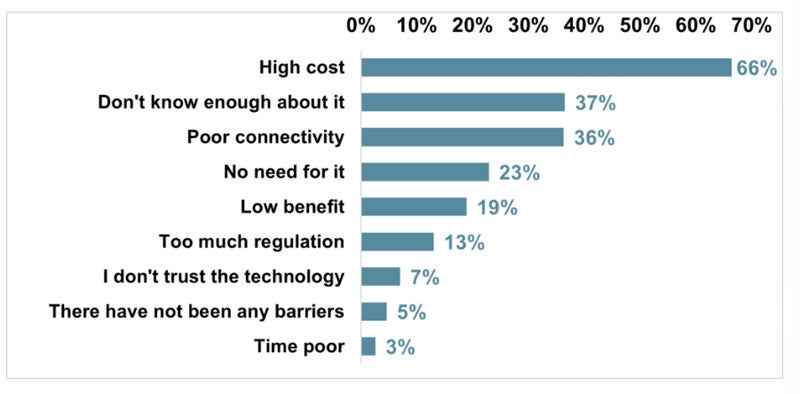An effort by the Australian government to support the nation’s farmers and other primary producers by incentivising investment in technology is driving growth in tech startups, fostering innovation, and boosting interest in new tech skills.
The government recently announced a second round of its On Farm Connectivity Program. This $18 million investment offers rebates of up to 50%, with a maximum of $30,000 for eligible equipment, aimed at extending data coverage and improving the connectivity and reliability of machinery and sensor technology.
As noted by the government, the initiative has supported:
- Soil moisture probes.
- Antennas.
- Liquid level monitors.
- Livestock monitoring systems.
- Weather monitors.
- Boosters and repeaters.
- Radio transmitters.
- Cameras.
- Water flow and pressure monitors.
The initiative is part of a larger $1.1 billion investment into rural Australia, under the Better Connectivity Plan.
Nearly 9 in 10 farmers interested in adopting AgTech solutions
This investment is significant as it allocates substantial funding directly to Australian businesses.
Australia is a leader in AgTech investment, making these government initiatives neither niche nor narrowly targeted. Roy Morgan research shows that:
- 89% of Australian farmers want to use AgTech solutions.
- 72% currently do.
- 6% of farmers trial AgTech solutions before giving up on the technology.
However, as Roy Morgan’s research also shows, the level of investment could be even higher. The biggest barrier to adopting AgTech solutions is “high cost,” which these government initiatives are actively helping to address.

The industry sees the potential for AgTech to convert interested farmers into customers. One company particularly involved in the project, Farmbot Australia, has claimed 441 rebates under the scheme, amounting to a total of $2.4 million.
Farmbot frequently uses the scheme in its marketing collateral to farmers.
A frenzy of investments into innovation
At the same time, the government is also actively supporting startups in the AgTech space with additional grant programs, such as the Industry Growth Program.
Under the program, startups and SMEs working on innovative solutions to sectors within the government’s “priority areas,” which includes Agriculture, can access up to $5 million in grants to commercialise and grow their operations. This has resulted in a flurry of investment interest in the sector. Examples include:
- Seed Terminator, which earned a $3.1 million grant earlier this year.
- Number 8 Bio, which aims to solve critical issues with the agriculture industry’s carbon footprint. The company raised $7 million in a funding round led by Main Sequence Ventures, an investment firm backed by the government’s CSIRO R&D organisation.
Meanwhile, another Australian AgTech startup tackling the same challenge was able to finalise a $17 million second Seed investment round after catching the eye of Microsoft founder Bill Gates.
Demand for AgTech skills is surging
The health of the Australian AgTech sector should result in positive outcomes for all technology sectors.
For example, demand for skills in this sector is encouraging the direct promotion of careers in the sector to regional Australia, where technology skills tend to be less of a priority.
Agvision Yanco, which took place in September, was the biggest regional event in NSW designed to promote careers in agriculture. It also introduced hundreds of students to various facets of AgTech in an effort to promote skills in STEM fields to regional students.
This event was an initiative of the NSW state government, recognizing the need for a sustainable AgTech sector to ensure the long-term health of the industry. The focus is on developing hardware and software products while also providing ongoing maintenance.
“Agriculture is an ‘engine room’ industry in NSW,” Tara Moriarty, minister for Regional NSW, said in a statement. “Farmers across the state produce more than $17 billion worth of food and fibre every year. Agricultural technology, ‘AgTech’, is vital to the ongoing success of the agricultural industry for our state.”
She added: “AgTech is transforming the agriculture industry across the globe, and it’s essential that NSW has the relevant skills to ensure we remain a world leader in the field.”
Like any other sector, AgTech relies on traditional IT to provide the foundation for innovation. In particular, AgTech has a strong demand for IoT, edge computing, and cloud computing solutions, as much of the technology is sensor-based and deployed remotely. With that comes the need for advanced cybersecurity solutions.
Australia’s thriving AgTech sector presents significant opportunities for the broader IT industry, while also creating new skills and opportunities for IT professionals in areas where IT has traditionally played a secondary role. In the longer term, this demand and opportunity will strengthen Australia’s innovation sectors and help address the skills shortages by creating stronger pathways into IT.


